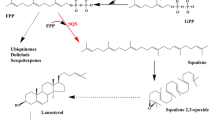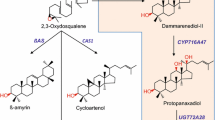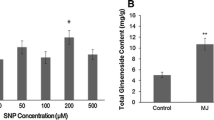Abstract
Squalene epoxidase (also called squalene monooxygenase) catalyses the conversion of squalene into 2,3-oxidosqualene by epoxidation and is regarded as the rate-limiting enzyme for sterol and saponin biosynthesis. However, the role of the squalene epoxidase gene in saponin biosynthesis in plants is not yet well understood. Here, we investigated the effects of overexpression of a Panax ginseng squalene epoxidase gene (PgSE1) on the production of phytosterols and ginsenoside saponins in ginseng adventitious roots. For the functional complementation test, the two squalene epoxidase sequences (PgSE1 and PgSE2) of P. ginseng were expressed in a yeast erg1 mutant (ergosterol auxotroph). The yeast mutant expressing PgSE1 or PgSE2 can restore growth on medium lacking ergosterol. Transgenic ginseng roots overexpressing the PgSE1 gene were constructed by Agrobacterium-mediated genetic transformation. The transgenic ginseng roots resulted in the enhanced production of both ginsenosides (ginsenoside Rg1, Re, Rf, Rc, Rb1, Rb2, and Rd) and phytosterols (campesterol, stigmasterol, and β-sitosterol). qPCR analysis revealed that overexpression of PgSE1 in transgenic ginseng roots clearly enhanced the expression of dammarenediol-II synthase (PgDDS) and cycloartenol synthase (PgPNX), which are key enzymes for ginsenoside and phytosterol biosynthesis in P. ginseng. This result indicates that the P. ginseng squalene epoxidase gene (PgSE1) encodes an efficient enzyme responsible for not only phytosterol production but also ginsenoside production in P. ginseng.








Similar content being viewed by others

Abbreviations
- RT-PCR:
-
Reverse transcription-PCR
- qPCR:
-
Quantitative real-time PCR
- MS:
-
Murashige and Skoog
- IBA:
-
Indolebutyric acid
- PgSE1:
-
Panax ginseng Squalene epoxidase 1
References
Benfey PN, Chua N-H (1990) The cauliflower mosaic virus 35S promoter: combinatorial regulation of transcription in plants. Science 250:959–966
Briskin DP (2000) Medicinal plants and phytomedicines. Linking plant biochemistry and physiology to human health. Plant Physiol 124:507–514
Choi YE, Yang DC, Kusano T, Sano H (2001) Rapid and efficient Agrobacterium-mediated genetic transformation by plasmolyzing pretreatment of cotyledons in Panax ginseng. Plant Cell Rep 20:616–621
Coleman CI, Hebert JH, Reddy P (2003) The effects of Panax ginseng on quality of life. J Clin Pharm Ther 28:5–15
Gundlach H, Müller MJ, Kutchan TM, Zenk MH (1992) Jasmonic acid is a signal transducer in elicitor-induced plant cell cultures. Proc Natl Acad Sci USA 89:2389–2393
Han JY, Jung SJ, Kim SW, Kwon YS, Yi MJ, Yi JS, Choi YE (2006) Induction of adventitious roots, analysis of ginsenoside and genes involved in triterpene biosynthesis in Panax ginseng. J Plant Biol 49:26–33
Han JY, In JY, Kwon YS, Choi YE (2010) Regulation of ginsenoside and phytosterol biosynthesis by RNA interferences of squalene epoxidase gene in Panax ginseng. Phytochemistry 71:36–46
Karst F, Lacroute F (1977) Ergosterol biosynthesis in Saccharomyces cerevisiae: mutants deficient in the early steps of the pathway. Mol Gen Genet 154:269–277
Kim JY, Adhikari PB, Ahn CH, Kim DH, Kim YC, Han JY, Kondeti S, Choi YE (2019) High frequency somatic embryogenesis and plant regeneration of interspecific ginseng hybrid between Panax ginseng and Panax quinquefolius. J Ginseng Res 43:38–48
Kribii R, Arro M, Del Arco A, Gonzalez V, Balcells L, Delourme D, Ferrer A, Karst F, Boronat A (1997) Cloning and characterization of the Arabidopsis thaliana SQS1geneencoding squalene synthase–involvement of the C-terminal region of the enzyme in the channeling of squalene through the sterol pathway. Eur J Biochem 249:61–69
Laranjeira S, Amorim-Silva V, Esteban A, Arró M, Ferrer A, Tavares RM, Botella MA, Rosado A, Azevedo H (2105) Arabidopsis squalene epoxidase 3 (SQE3) complements SQE1 and is important for embryo development and bulk squalene epoxidase activity. Mol Plant 8:1090–1102
Lee MH, Jeong JH, Seo JW, Shin CG, Kim YS, In JG, Yang DC, Yi JS, Choi YE (2004) Enhanced triterpene and phytosterol biosynthesis in Panax ginseng overexpressing squalene synthase gene. Plant Cell Physiol 45:976–984
Murashige T, Skoog F (1962) A revised medium for rapid growth and bioassays with tobacco tissue. Physiol Plant 15:473–497
Nicol RW, Traquair JA, Bernards MA (2001) Ginsenosides as host resistance factors in American ginseng (Panax quinquefolius). Can J Bot 80:557–562
Park JD, Rhee DK, Lee YH (2005) Biological activities and chemistry of saponins from Panax ginseng C. A Meyer Phytochem Rev 4:159–175
Rasbery JM, Shan H, LeClair RJ, Norman M, Matsuda SP, Bartel B (2007) Arabidopsis thaliana SQUALENE EPOXIDASE 1 is essential for root and seed development. J Biol Chem 282:17002–17013
Ryder NS (1991) Squalene epoxidase as a target for the allylamines. Biochem Soc Trans 19:774–777
Shibata S (2001) Chemistry and cancer preventing activity of ginseng saponins and some related terpenoid compounds. J Kor Med Sci 16:S28–37
Sung WS, Lee DG (2008) In vitro candidacidal action of Korean red ginseng saponins against Candida albicans. Biol Pharm Bull 31:139–143
Suzuki H, Achnine L, Xu R, Matsuda SPT, Dixon RA (2002) A genomics approach to the early stages of triterpene saponin biosynthesis in Medicago truncatula. Plant J 32:1033–1048
Unland K, Pütter KM, Vorwerk K, van Deenen N, Twyman RM, Prüfer D, Schulze Gronover C (2018) Functional characterization of squalene synthase and squalene epoxidase in Taraxacum koksaghyz. Plant Direct 2:e00063
Vogler BK, Pittler MH, Ernst E (1999) The efficacy of ginseng. A systematic review of randomised clinical trials. Eur J Clin Pharmacol 55:567–575
Yoshioka H, Coates HW, Chua NK, Hashimoto Y, Brown AJ, Ohgane K (2020) A key mammalian cholesterol synthesis enzyme, squalene monooxygenase, is allosterically stabilized by its substrate. Proc Natl Acad Sci USA 117:7150–7158
Zhang DH, Jiang LX, Li N, Yu X, Zhao P, Li T, Xu JW (2017) Overexpression of the squalene epoxidase gene alone and in combination with the 3-hydroxy-3-methylglutaryl coenzyme A gene increases ganoderic acid production in Ganoderma lingzhi. J Agric Food Chem 65:4683–4690
Acknowledgements
This work was supported by the Rural Development Administration, Republic of Korea [Next-Generation Bio-Green 21 Program (PJ01344401)], and Kangwon National University.
Author information
Authors and Affiliations
Contributions
YEC designed the research and wrote the paper. JYH performed the analysis of the phytochemicals by LC and GC/MS. HJC performed the genetic transformation and PCR experiments. All authors read and approved the manuscript.
Corresponding author
Ethics declarations
Conflict of interest
The authors declare that they have no conflicts of interest.
Additional information
Publisher's Note
Springer Nature remains neutral with regard to jurisdictional claims in published maps and institutional affiliations.
Electronic supplementary material
Below is the link to the electronic supplementary material.
Rights and permissions
About this article
Cite this article
Han, J.Y., Jo, HJ. & Choi, Y.E. Overexpression of the squalene epoxidase gene (PgSE1) resulted in enhanced production of ginsenosides and phytosterols in transgenic ginseng. Plant Biotechnol Rep 14, 673–682 (2020). https://doi.org/10.1007/s11816-020-00643-4
Received:
Accepted:
Published:
Issue Date:
DOI: https://doi.org/10.1007/s11816-020-00643-4



